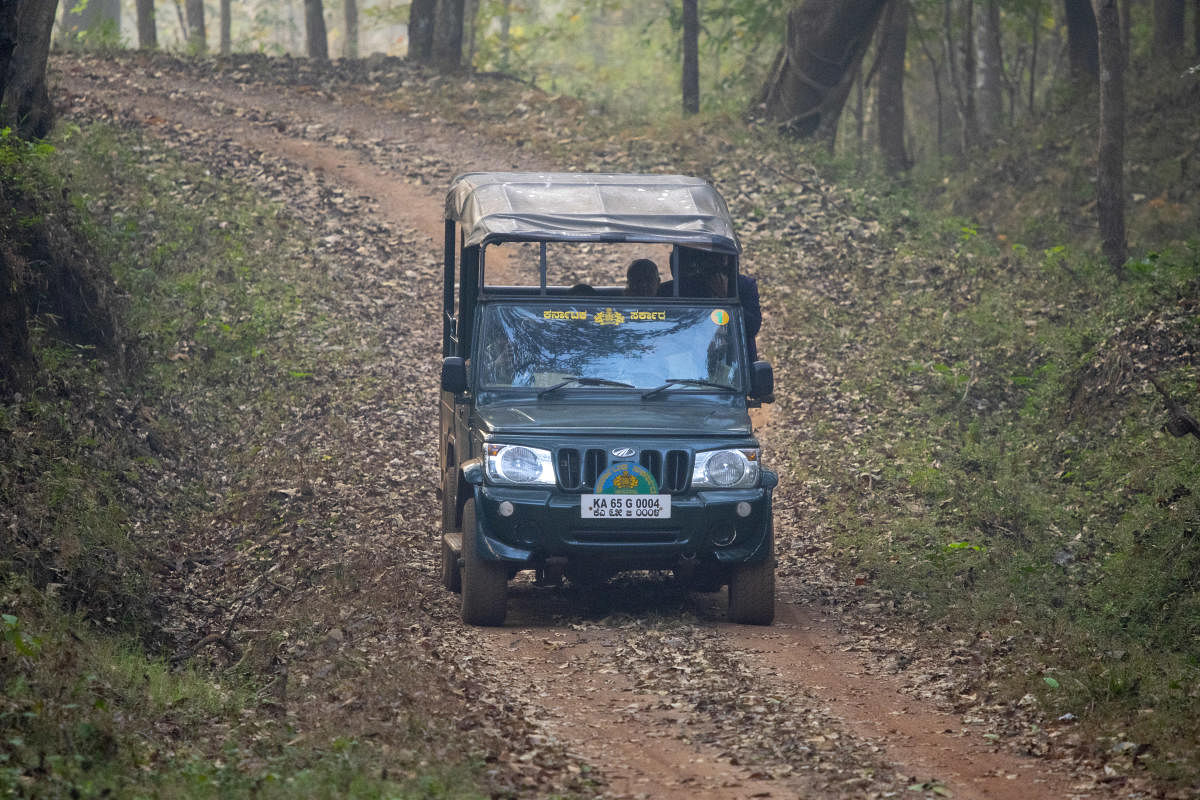

The news of sighting two leopards including a melanistic leopard, also known as the blank panther, for two straight days in the Kali Tiger Reserve (KTR) in the first week of February was exciting.
I heard people telling stories about sighting the black panther while driving back from Dandeli, Kulagi, Ulavi and other places in Joida taluk of Uttara Kannada district.
The Kali Tiger Reserve is known for its black panthers and the prospect of sighting the two leopards, believed to be sisters, prompted me and my friend to pack our bags for a day’s visit.
The forest department operates the safari twice a day—once in the morning at 5:30 and once in the afternoon at 3:30. Each ride inside the forest is for nearly two-and-a-half hours. We had booked our slot for the evening as the chances of sighting the animals were high. The previous sighting was also in the late evenings.
The well-maintained jeeps of the department waded through the human habitation for half a kilometre before entering the second gate of the safari zone. The jungle here is pristine. The safari zone is a mixture of grassland, deciduous forest and evergreen forest. We can also see the backwaters of the Kali river.
As our jeep traversed through 24 km of the dense jungle, we passed through several waterholes and the Shanmugan viewpoint which has a breathtaking view of the vast and thick jungle of the KTR.
Our driver told us that the forest department through camera trapping had recorded the presence of seven tigers, all of them in the age range of four to seven, and healthy. The camera traps had also recorded the presence of at least 13 black panthers and some 80-90 leopards in the Kulagi and Pansoli ranges, the portion of which is covered under the safari area.
Birding
We also sighted Malabar pied hornbill, Malabar grey hornbill, which are among four species of the hornbill found here, the Indian grey hornbill and great hornbill being the other two.
Over the next two hours, we sighted several herds of spotted deer, a hulk-like Indian guar, sambar deer, barking deer and birds like serpent eagle, Indian roller, paradise flycatcher, a few woodpeckers among others.
KTR is sought after among bird photographers. Given the thickness of the forest, it is hard for one to sight animals, especially predators during the safari. We were not so lucky to sight any of the big cats—tiger, leopard, jungle cat and leopard cat—or the wild dogs (doles).
Naturalist Vishnumurthy Shanbhag, who recently captured the sub-adult panthers sitting on a tree, says it was an unforgettable moment for him to capture the two leopards at a time. “While the normal leopard is quite shy, the black panther seems to be bold and did not bother to hide behind the branches of the tree for almost one hour that we stayed there to shoot it.”
Naturalists who have sighted this black panther now plan to name it ‘Kali’. “If she continues to give us ‘darshan’ at regular intervals, then she can give a tough competition to Saaya or ‘Dark Lord of Kabini’ (the famous black panther at the Antharsanthe safari zone), ” says Vishnumurthy.
KTR is North Karnataka’s only tiger park and several local people are pinning their hopes on this jungle safari becoming a favourite. Unlike other tiger reserves, where the government-controlled Jungle Lodges and Resorts manages the jungle safari; in KTR, the forest department has allowed the eco-development committee (EDC) which consists of local people mostly from indigenous communities to operate jungle safaris.
Local involvement
Through this committee, 18 people have taken permission to operate jeep safari, after being trained by the forest department to not just identify the bird species but also on how to safely navigate in case of animal encounters. A total of 22 local youth including 18 drivers-cum-guides, office boys and two watchers have been employed.
Krishna Desai, President of Pansoli EDC, says local people’s involvement is a must in the conservation of the forest and unless these people financially benefit directly or indirectly, it would be difficult to protect both wildlife and the jungle.
While 75% of the revenue thus earned by safari goes to the EDC, the remaining 25% is shared with Forest Department.
Desai said ever since the government allowed the locals to start eco-tourism in 2011, there has been an increase in enthusiasm in locals to protect forests. “Poaching incidents were rarely reported in KTR. However, earlier tree felling and fire incidents used to take place. Involvement of local people has improved the conservation work. ECD has also hired two youths to ensure stray cattle and humans do not venture into forests,” he said.
For Dr Sumanth Hosmath of Hubballi, KTR is a stress buster. “Even before I enter the safari zone, I make peace with the fact that I might not sight any wild animals. I visit this place for its tranquillity, fresh air and the surprise it throws. Never have I returned disappointed or without memories,” he said.